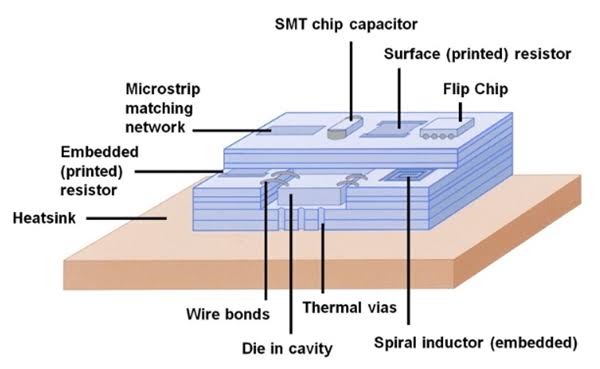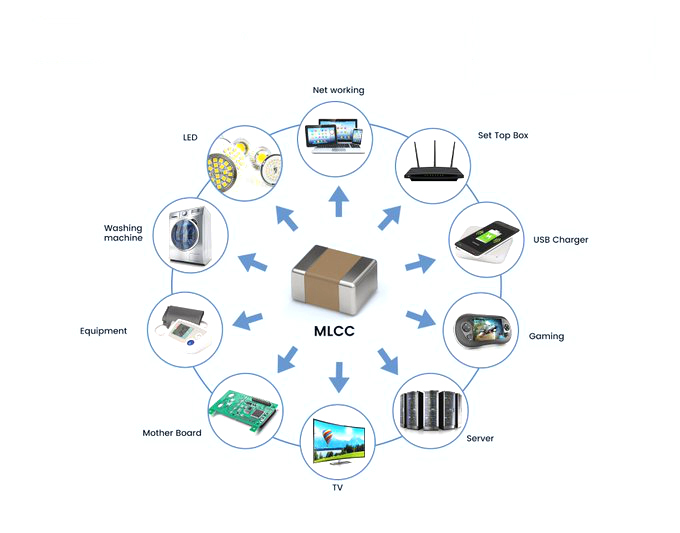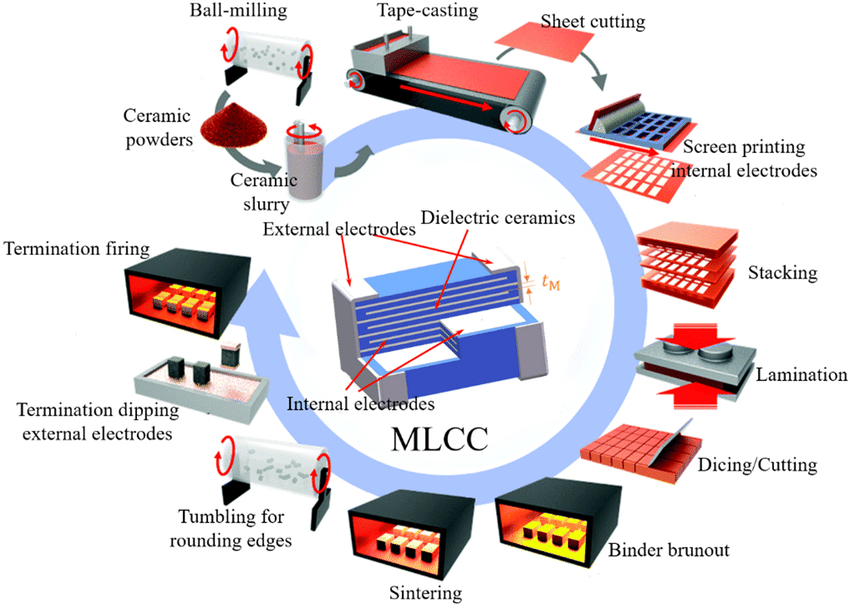Multilayer Ceramic Capacitors (MLCCs) have revolutionized the electronics industry with their compact size and exceptional performance. Behind their remarkable capabilities lie three core technologies: ceramic powder, dielectric layering printing, and co-firing technique. This article will delve into the specifics of these foundational technologies that make MLCCs an integral part of modern electronics.
Ceramic Powder: The Genesis of Dielectric Properties
The journey of MLCCs commences with ceramic powder, a critical ingredient that defines the capacitor’s dielectric properties. Ceramic powders are meticulously chosen for their dielectric constant, temperature stability, and voltage coefficients. Common materials include barium titanate (BaTiO3) and its derivatives like barium strontium titanate (BST).
The ceramic powders undergo careful processing to achieve the desired characteristics. They are blended to specific ratios to fine-tune capacitance values, temperature coefficients, and other performance attributes. This precise control over ceramic powder compositions ensures that MLCCs deliver consistent and reliable performance across various applications.

Dielectric Layering Printing: Crafting Precision Layers
The dielectric layering printing process is where the essence of MLCCs takes shape. This technique involves depositing layers of ceramic slurry onto a substrate using advanced printing methods like screen printing or inkjet printing. Each layer is carefully printed to achieve the desired thickness, uniformity, and dielectric properties.
The slurry is a mixture of ceramic powders, binders, and solvents. The challenge lies in formulating a slurry with the right viscosity to enable controlled deposition while ensuring minimal shrinkage during subsequent processing.
The result of this process is a precisely constructed stack of dielectric layers, each contributing to the overall capacitance of the MLCC. Insulating layers are incorporated to prevent short circuits and ensure the proper functioning of the capacitor.

Co-Firing Technique: The Art of Integration
The co-firing technique is where the individual layers of the MLCC come together to form a cohesive and functional unit. The stacked layers are subjected to a high-temperature firing, allowing the ceramic powders to sinter and fuse. This creates a solid structure with well-defined capacitance values and dielectric properties.
Achieving successful co-firing requires careful control of temperature, time, and atmosphere. The firing process must be optimized to ensure the ceramics fuse without warping or delaminating, resulting in a reliable and durable MLCC.

Synergy in Action: Creating Modern MLCCs
The synergy of these core technologies is evident in every MLCC. Ceramic powder forms the heart of the dielectric, dielectric layering printing meticulously constructs precise layers, and co-firing technique brings it all together. This integration culminates in a compact, efficient, and reliable capacitor that stores and releases electrical energy across various applications.
From smartphones to automotive electronics, MLCCs powered by these core technologies have become indispensable components in modern electronics, enabling improved performance, noise suppression, and signal integrity across a wide range of devices and industries.

Innovations and Advancements: Pushing the Boundaries
While the core technologies of ceramic powder, dielectric layering printing, and co-firing technique have laid the foundation for MLCCs, ongoing research, and innovations continue to push the boundaries of what these capacitors can achieve.
Advanced Ceramic Materials: Beyond the traditional ceramic powders, researchers are exploring advanced materials with tailored properties. Nanocomposite ceramics, for instance, offer enhanced dielectric properties and reduced size effects. These materials promise higher capacitance values in smaller packages, catering to the demand for miniaturization.
Multilayer Technology: The concept of multilayer technology has evolved beyond capacitors. Researchers are experimenting with incorporating passive components like resistors and inductors into the same multilayer structure. This integration aims to enhance circuit performance further and reduce space requirements.
Stacking Techniques: Stacking techniques have evolved to accommodate more layers within a given space, increasing the overall capacitance density. Advanced dielectric layering printing methods enable even finer layer deposition, contributing to the miniaturization trend without compromising performance.
Reliability Enhancement: Efforts are being made to improve MLCC reliability in demanding environments. This involves addressing issues like thermal stress, mechanical durability, and long-term stability under various operating conditions. Novel electrode materials and encapsulation techniques are being explored to enhance MLCC robustness.

Conclusion: The Ever-Evolving MLCC Landscape
The core technologies of ceramic powder, dielectric layering printing, and co-firing technique have paved the way for MLCCs to become the versatile and efficient components we know today. Yet, the journey doesn’t stop there. The field of MLCC technology continues to evolve, driven by the quest for improved performance, miniaturization, and reliability.
As we peer into the future, the landscape of MLCCs promises even more remarkable developments. From advanced materials to novel integration techniques, these capacitors are poised to shape the electronics industry in unprecedented ways. Whether powering our smartphones or propelling cutting-edge technologies, MLCCs remain at the forefront of innovation, with their core technologies serving as the foundation for ongoing progress.
The Multilayer Ceramic Capacitors from RisunSemi
RisunSemi recommends high-quality Multilayer Ceramic Capacitors to you. Click the link below to search for the Multilayer Ceramic Capacitors you need!
